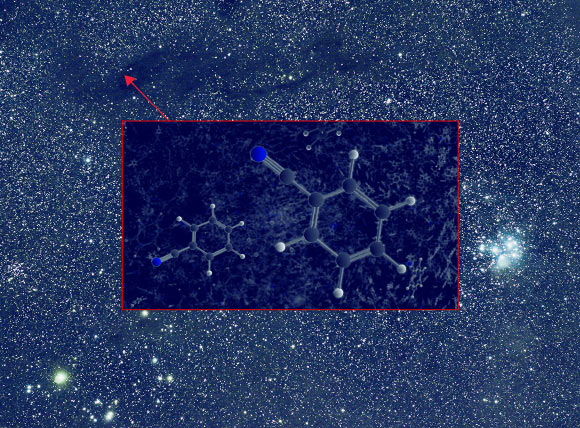Astronomers studying a well-known nearby cloud of interstellar gas with radio telescopes have detected the presence of benzonitrile (c-C6H5CN), an intriguing organic molecule that helps to chemically link simple carbon-based molecules and truly massive ones known as polycyclic aromatic hydrocarbons (PAHs). The finding marks the first time a specific aromatic molecule has been identified in space using radio spectroscopy.

The aromatic molecule benzonitrile was detected by NSF’s Green Bank Telescope in the Taurus Molecular Cloud 1. Image credit: B. McGuire & B. Saxton / NRAO / AUI / NSF.
Organic molecules containing a hexagonal ring of carbon atoms, known as aromatic molecules, are abundant throughout the Universe.
Astronomers know this because these molecules emit a characteristic set of emission features in the infrared, which are observed in many space environments.
However, identifying precisely which aromatic molecules are present is very difficult, and usually requires radio spectroscopy.
Improved methods for detecting weak radio emission are helping astronomers gain a better glimpse into the cosmos.
A research team led by chemist Dr. Brett McGuire of the National Radio Astronomy Observatory took advantage of such a method — a so-called spectral-stacking procedure — to find signatures of benzonitrile while combing through a radio survey of a star-forming nebula known as the Taurus Molecular Cloud 1 (TCM-1), which is approximately 430 light-years from Earth.
“These new radio observations have given us more insights than infrared observations can provide,” Dr. McGuire said.
“Though we haven’t yet observed PAHs directly, we understand their chemistry quite well.”
“We can now follow the chemical breadcrumbs from simple molecules like benzonitrile to these larger PAHs.”
To confirm their identification, the researchers conducted thorough lab experiments to accurately measure the different rotational transitions of the molecule.
By comparing their experimental data to targeted observations of TMC-1 using another radio telescope, they were able to observe nine different rotational transitions of benzonitrile, solidifying the detection.
“Though benzonitrile is one of the simplest so-called aromatic molecules, it is in fact the largest molecule ever seen by radio astronomy,” the scientists noted.
“It also is the first six-atom aromatic ring molecule ever detected with a radio telescope (NSF’s Green Bank Telescope).”
“The evidence that the Green Bank Telescope allowed us to amass for this detection is incredible,” Dr. McGuire said.
“As we look for yet larger and more interesting molecules, we will need the sensitivity of this telescope, which has unique capabilities as a cosmic molecule detector.”
The team’s results were published in the January 12 issue of the journal Science.
_____
Brett A. McGuire et al. 2018. Detection of the aromatic molecule benzonitrile (c-C6H5CN) in the interstellar medium. Science 359 (6372): 202-205; doi: 10.1126/science.aao4890







